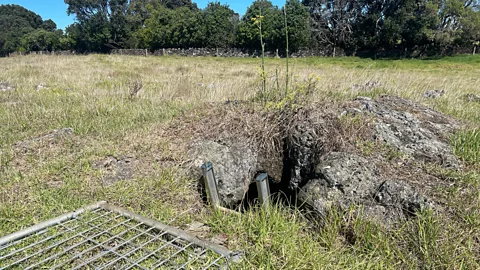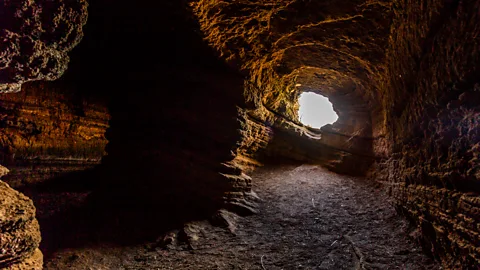Charlotte LyttonFeatures correspondent

 Getty Images
Getty Images
Auckland is the largest city in New Zealand and beneath it lies an equally sprawling network of lava caves.
The manhole cover in the middle of a grassy paddock is the only giveaway. In a field in central Auckland, New Zealand – where a sign warns of roaming bulls – sits the entrance to a lava cave likely formed 70,000 years ago: one among the hundreds that lie beneath the city.
With a previously unknown cave being discovered each month, a new mapping project is underway to pinpoint their exact whereabouts, provide a blueprint for other volcanic areas globally – and potentially avert future disaster.
Auckland's status as a city built on an active volcanic field is "really special and unusual", says Kate Lewis, geoheritage and natural features expert at Auckland Council. That makes it all the more important – and challenging – to earmark and protect the caves, which are formed after eruptions. "There's a hazard component, there's an engineering component, there's a heritage component," she explains. "And then there's a huge cultural component as well."
Rocks carpet the ground of the 70,000-year-old cave we are standing in, moss and fern clinging in patches overhead in the 10ft-high (3m) hole that would have formed "pretty quickly" once an eruption began. What are now the city's caves have taken shape over the space of 200,000 years, with the newest being created after the eruption of Rangitoto – the only mountain in Auckland to blow twice – around 550 years ago.

 Charlotte Lytton
Charlotte Lytton
"Lava caves are empty lava tubes that develop during transport of usually fluid molten lava," explains David Clague, a volcanologist at the Monterey Bay Aquarium Research Institute in California. During energetic eruptions, molten rock pours out onto the Earth's surface, moving downhill before cooling, and forming a crust.
"Initially, when molten rock lava hardens, it's very, very glassy, and it's an incredible insulator, so these can go on for miles," Lewis adds, describing the flowing material as "like molasses or honey". When the lava supply is cut off, either because the magma has stopped rising, or because it has been diverted elsewhere, it drains out, with the caves' empty pockets left behind.
Caves "occur in most lava flows, but are most common where the lavas are fluid and flow rapidly", Clague says, making them common features in the likes of Hawaii and Iceland, as well as oceanic volcanic island groups such as the Galapagos, the Azores and Tahiti.
Lava caves are not only a geological quirk, but have come to have both practical and cultural significance over the millennia
The longest of those in Auckland run up to 290m (957ft); in the US, that figure is closer to 4km (2.5 miles), with Ape Cave at the Gifford National Park in Washington the longest continuous tube in North America.
The US versions, which can be found in states including Hawaii, California (where the Lava Beds National Monument resides), New Mexico, Oregon, Utah and Arizona, can be far more labyrinthine than their Antipodean equivalents. Some have splits and junctions, different levels and sudden drops, mimicking the way the lava moved through them thousands of years ago.
Lava caves are not only a geological quirk, but have come to have both practical and cultural significance over the millennia. At Bobcat Cave in Idaho, research has shown that Native Americans used the structures as fridges in hard times, likely preserving bison meat during fallow hunting periods.

 Charlotte Lytton
Charlotte Lytton
For the Māori, who first settled New Zealand around the 13th Century, a number of Auckland's caves are sacred, used as burial sites for human remains (or koiwi). Since the early 1800s, however, when the country was formed and given British sovereign rule, uncovered koiwi have been stolen for the likes of private collections and museums, in some cases reaching as far as the UK or US.
This demonstrates a "lack of care or understanding by new people coming in who haven't respected those sites", says Malcolm Paterson, a local Māori heritage practitioner who belongs to the Ngāti Whātua tribe of the Auckland region. In his lifetime, human remains have been taken from caves, sometimes "for really disrespectful purposes; a skull paperweight, for example. We've all seen and know of where our sacred places haven't been treated in the way that we would like".
The caves have also been found to have been repurposed as a clandestine Communist printing press in 1940 (stumbled upon by three schoolboys), a mushroom farm in the 1960s, and more recently, in an advert for a house for sale – recast as a wine cellar. "Using them today for profane reasons would be the same as going into a church and having a party – it's not appropriate," Paterson says.
As development projects spread across the city, the phone rings each time a digger hits a cave
These are among the problems Lewis's team are tasked with solving: how to manage caves discovered on private land, which make up the vast majority (believed to be around 90% of those in the city). There is an "accidental discovery rule" in place for those who do inadvertently strike upon one, which demands "the same procedure as if someone discovers an archaeological site or hazardous waste, or bones in a cemetery, and they have to stop work and protect the area".
As development projects spread across the city, the phone rings each time a digger hits a cave, at which stage Lewis and her colleagues will assess its size and features. "We look inside, and then try to work out what we do with the contractors, with the landowners, [and] how we can preserve the cave while continuing the building project. That's been quite a job."

 Getty Images
Getty Images
For private owners, finding what is tantamount to archaeological remains beneath their homes isn't always a boon. Most choose to keep it quiet, both in order to avoid locals and tourists arriving to take a look (I am not allowed to name the cave we meet in on public land due to the surge in interest since the mapping project was announced), and because they become "quite worried about their land value. If someone had this under their land, that would be the end of a basement, the end of a swimming pool," Lewis says. "People get kind of touchy about it."
Discovering a cave can also be dangerous. There have been instances where diggers have crashed into holes, and as construction continues across Auckland, that may well become a common feature. "We have limited housing, so we're looking at intensification or increased development across the city," says Jaxon Ingold, a Master's student at the University of Auckland who is working on the mapping project.
"With this [increased] construction, there will be more building and more excavation, so definitely more lava caves will be found." This not only potentially affects construction workers, but "has threatened many of Auckland's lava caves, placing them at risk of destruction".
Following severe flooding in Auckland last year, geologists know that water can flow easily through the caves
Along with manmade issues, there are geological ones, too: Auckland "has the potential for an eruption at any time", Lewis points out. To prevent a future disaster, there is active monitoring and a volcanic contingency plan designed by Devora (Determining Volcanic Risk in Auckland, funded by the Earthquake Commission and Auckland Council).
Unsure where the next eruption will be, Devora has mapped out seven different scenarios across various parts of Auckland, "so if there's an eruption there, what might it look like? How might that volcano behave? What would be the evacuation issues? What would be issues for infrastructure?" Authorities, Lewis adds, "take it quite seriously, because the chance of this happening is quite low in anyone's lifetime. But the impact would be enormous".
More like this:
• The bunker builders preparing for doomsday
Creating the first-ever database of Auckland's lava caves will prove, they hope, an opportunity to arm the city – and perhaps others – against future hazards. "Looking at past lava flows [the hard rock that flowed in a volcano's eruptive history] can help us learn more about the way lava flows travel," Ingold says.
While caves like this one in central Auckland are sealed but for the entrance, for lava caves in the likes of Hawaii "that are potentially open in more than one places, lava – if it flows into an old tube – can then flow through and reactivate potentially, further down". Following severe flooding in Auckland last year, geologists know that water can flow easily through the caves, raising the likelihood that molten lava could again.
Ingold hopes that his work might provide a blueprint for other similarly volcanic areas around the world. Though he knows that there would be "different needs, depending on where you were in the world, depending on what happens nearby, or how strong the cultural element is, or what the hazard risk is". Still, the idea that this nascent database might redefine the future of lava caves globally would, he admits, "be very cool".
--